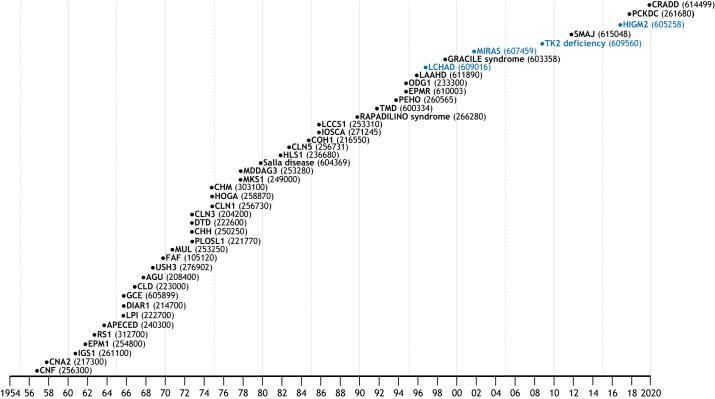Fig. 1.
Updated ‘Perheentupa Steps’. This widely used traditional representation of the Finnish disease heritage (FDH) diseases organizes them chronologically based on the year in which the disease description was published. The respective Online Mendelian Inheritance in Man (OMIM) codes are in parentheses. FDH diseases are in black and candidate diseases in blue. CNF, Finnish congenital nephrosis (Ahvenainen et al., 1956); CNA2, cornea plana 2 (Forsius, 1957); IGS1, Imerslund-Grasbeck syndrome 1 (Gräsbeck et al., 1960); EPM1, epilepsy, progressive myoclonic, 1 (Harenko and Toivakka, 1961); RS1, retinoschisis 1 (Forsius et al., 1962); APECED, autoimmune polyendocrinopathy-candidiasis-ectodermal dystrophy – type 1 with or without reversible metaphyseal dysplasia (Visakorpi and Gerber, 1963); LPI, lysinuric protein intolerance (Perheentupa and Visakorpi 1965); DIAR1, diarrhea, secretory chloride, congenital (Perheentupa et al., 1965); GCE, glycine encephalopathy (Visakorpi et al., 1965); CLD, lactase deficiency, congenital (Launiala et al., 1966); AGU, aspartylglucosaminuria (Palo, 1967); USH3, Usher syndrome type 3 (Nuutila, 1968); FAF, amyloidosis, Finnish type (Meretoja, 1969); MUL, Mulibrey nanism (Perheentupa et al., 1970); PLOSL1, polycystic lipomembranous osteodysplasia with sclerosing leukoencephalopathy 1 (Hakola, 1972); CHH, cartilage-hair hypoplasia (Perheentupa, 1972); DTD, diastrophic dysplasia (Perheentupa, 1972); CLN3, ceroid lipofuscinnosis, neuronal, 3 (Santavuori, 1972); CLN1, ceroid lipofuscinosis, neuronal 1 (Santavuori et al., 1973); HOGA, hyperornithinemia with gyrate atrophy of choroid and retina (Simell and Takki, 1973); CHM, choroideremia (Takki, 1974); MKS1, Meckel syndrome type 1 (Aula et al., 1977); MDDAG3, muscular dystrophy-dystroglycanopathy (congenital with brain and eye anomalies), type a, 3 (Santavuori, et al., 1977); Salla disease (Aula et al., 1979); HLS1, hydrolethalus syndrome 1 (Salonen et al., 1981); CLN5, ceroid lipofuscinnosis, neuronal, 5 (Santavuori et al., 1982); COH1, Cohen syndrome (Norio et al., 1984); IOSCA, infantile-onset spinocerebellar ataxia (Kallio and Jauhianen, 1985); LCCS1, lethal congenital contracture syndrome 1 (Herva et al., 1985); RAPADILINO syndrome (Kaariainen et al., 1989); TMD, tibial muscular dystrophy (Udd et al., 1991); PEHO, progressive encephalopathy with edema, hypsarrhythmia and optic atrophy (Salonen et al., 1991); EPMR, epilepsy, progressive, with mental retardation (Hirvasniemi et al., 1994); ODG1, ovarian dysgenesis 1 (Aittomäki, 1994); LAAHD, lethal arthrogryposis with anterior horn cell disease (Vuopala et al., 1995); LCHAD, long-chain 3-hydroxyacyl-CoA dehydrogenase deficiency (Tyni et al., 1996); GRACILE syndrome (Fellman et al., 1998); MIRAS, mitochondrial recessive ataxia syndrome (Rantamäki et al., 2001); TK2 deficiency (Götz et al., 2008); SMAJ, spinal muscular atrophy, Jokela type (Jokela et al., 2011); HIGM2, hyper-IgM syndrome type 2 (Trotta et al., 2016); PCKDC, phosphoenolpyruvate carboxykinase deficiency, cytosolic (Vieira et al., 2017); CRADD, frontotemporal pachygyria (Polla et al., 2019). Original illustration of the steps was first used by Prof. Jaakko Perheentupa and colleagues (Norio et al., 1973).

